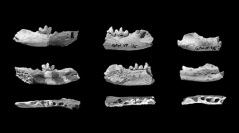

 Comptes Rendus Palevol
7 (8) - Pages 557-569
Comptes Rendus Palevol
7 (8) - Pages 557-569New observations on the Late Miocene and Earliest Pliocene mustelids from the Middle Awash of Ethiopia are presented. The Middle Awash study area samples the last six million years of African vertebrate evolutionary history. Its Latest Miocene (Asa Koma Member of the Adu-Asa Formation, 5.54–5.77 Ma) and Earliest Pliocene (Kuseralee and Gawto Members of the Sagantole Formation, 5.2 and 4.85 Ma, respectively) deposits sample a number of large and small carnivore taxa among which mustelids are numerically abundant. Among the known Late Miocene and Early Pliocene mustelid genera, the Middle Awash Late Miocene documents the earliest Mellivora in eastern Africa and its likely first appearance in Africa, a new species of Plesiogulo, and a species of Vishnuonyx. The latter possibly represents the last appearance of this genus in Africa. Torolutra ougandensis is known from both the Late Miocene and Early Pliocene deposits of the Middle Awash. The genus Sivaonyx is represented by at least two species: S. ekecaman and S. aff. S. soriae . Most of the lutrine genera documented in the Middle Awash Late Miocene/Early Pliocene are also documented in contemporaneous sites of eastern Africa. The new observations presented here show that mustelids were more diverse in the Middle Awash Late Miocene and Early Pliocene than previously documented.
Mustelids, Late Miocene, Early Pliocene, Middle Awash, Ethiopia